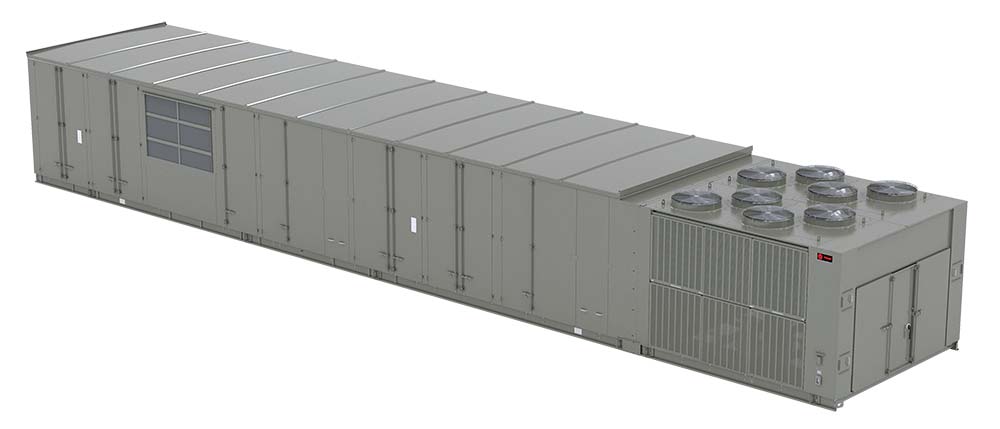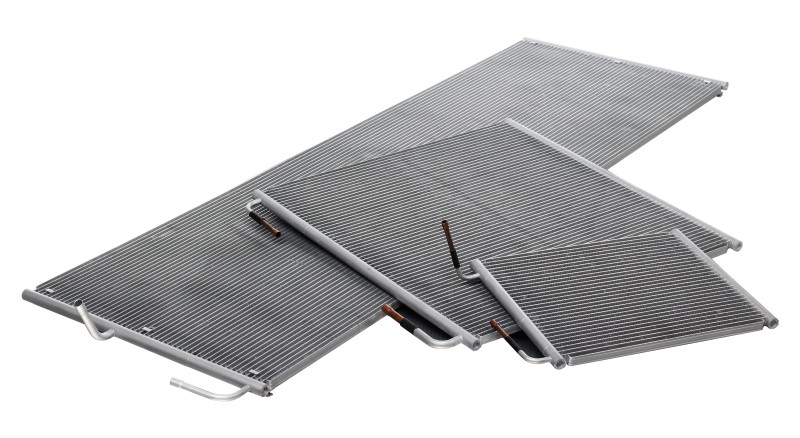The second phase of the Department of Energy’s (DOE’s) new efficiency standards is quickly approaching. In January 2023, the new standard will require commercial systems, including rooftop units, to achieve an additional 15% efficiency.
While the new standards drive innovation and opportunity within the HVAC industry, they also adds stress, pressure, and complexity to product developers and manufacturers as they brainstorm how to meet and communicate the next set of efficiency standards to come.
What Does This Mean for HVAC?
There are a few things this means for the industry. But the recurring theme is the innovation it will inevitably result in.
“It gives HVAC manufacturers the opportunity to innovate. And not just when it comes to energy efficiency, but in other areas as well,” said Aaron Olita, director of unitary/rooftop products at Trane Commercial.

ROOFTOP: Rooftop units to come will need to be more advanced, so manufacturers and product developers will need to rise to the occasion. (Courtesy of Trane Commercial)
It’s also a big step toward reducing greenhouse gas emissions. The new efficiency standards also require manufacturers to take features that have been mostly reserved for their mid and high-efficiency markets — things like oscillating fan control, multiple stages of compression — and make them the standard, said Matt Dodds, program director for product development at Daikin Applied’s air handling business.
With an increase in rooftop technology that is energy-efficient and meets DOE standards, basic efficiency models that make up a large portion of sales volume will increase in price, said Brian Dail, air conditioning segment marketing manager, Danfoss.
This means a few things for manufacturers. They’ll have to evaluate all product offerings that are impacted by the new efficiency standards, communicate effectively with all parties that correlate with the new updated product offerings, ensure those installing the product are informed so they can service and install with confidence, brainstorm how to meet future efficiency standards, continue to sell products, and manage expectations with customers on the upcoming changes.
But, no pressure.
“Our products becoming more complex, and that complexity has to be brought to a level where everybody can understand and be comfortable,” Olita said.
Chris Forth, vice president, regulatory, codes and environmental affairs, ducted systems, at Johnson Controls, said that the new standards create a huge opportunity for the HVAC industry. “Instead of contractors simply changing out individual system components, there’s opportunity for them to sell more complete, split residential systems and higher-efficiency commercial equipment.”
To Repair or Replace
The energy efficiency standards will continue to increase. Companies like Daikin have multiyear strategies to continue to move the needle and be a few steps of where the regulations are.
“But also so we can offer solutions that are above and beyond the minimums,” Dodds said.
Olita said the continuous increases in efficiency standards really changes the dynamics and the conversations around whether or not a builder would repair or replace a product.
Dodds said he hopes the new efficiency standards makes it easier for a building owner to decide to repair/replace equipment to meet new standards.
“The new equipment is just going to be that much more efficient than the existing equipment … that will see more ROI from an energy perspective. That should help them justify making the switch maybe a few years earlier than they would have.”
Dail mentioned that the increased price of a unit in 2023 compared to 2022 may encourage a building owner to repair instead of replace. However, he said the type of refrigerant and its availability will have a bigger impact than the new efficiency standards.
“The Inflation Reduction Act goes into effect starting January 1, 2023. The incentives for energy efficiency will be a huge influence on the decision to replace older equipment with higher-efficiency new equipment.”
These new efficiency standards aren’t a surprise to the industry. At this point, most equipment manufacturers should have already incorporated the new standards into their product designs.
Yet manufacturers have to think ahead about how they will continue to meet increasing efficiency standards for the next generation of products that need to be 20% or 30% more efficient.
Dodds said for him, it’s been mostly about going back and eliminating old technology that doesn’t meet the new standards.
Forth noted that there the DOE 2023 standards are followed by another regulation in 2025: the EPA transition to low-GWP refrigerants.
“That is a very compressed timeframe to replace your entire offering, especially given the supply chain issues and labor shortages that contractors are facing at the same time.”
Supply Chain
What the new standards do for the supply chain is they force it to be more robust in the areas it’s been challenged with lately. With more silicon chips required and more emphasis on variable-speed equipment, there is more of a requirement for advanced technology in a baseline product, Dodds said. Everything will need to be stronger in order to support the continually increasing standards.
Olita brought it back to the complexity of products. A lot of that complexity is brought from microprocessor and electronics that are used in many different types of products — “and products in the HVAC industry are not exempt from that.”
“Manufacturers might need new components that could be as varied as new compressors, new coils, or new controls,” Dail said.
They’ll have to work with component suppliers to make sure stock and production can provide them with new components. Dail added that Danfoss is currently in this process, ensuring the efficiency standards won’t affect its customers’ abilities to supply products.
Trane’s supply chain management teams work to ensure they have the necessary components to build products for its customers.
“So it’s just an added layer of oversight that we have to have now that the supply chain situation is what it is,” Olita said.

MCHEs: Microchannel heat exchangers provide higher efficiency and performance. (Courtesy of Danfoss)
The Good and the Bad
While the new efficiency standards set the industry up for a future of innovation, they also put an immense amount of pressure and stress on the industry to continue to meet new standards.
“There is a large amount of work and testing to do. The manufacturers that can work with the suppliers well and accurately simulate performance, before prototypes are built, will be able to quickly adapt and innovate in this rapidly changing environment,” Dail said.
Olita said the biggest challenges relate back to the complexity of the products and how to communicate with customers in a way that they’ll understand the difference and similarities between new and old products and technologies, and how they operate. At the same time, as products get more complex, customers are more comfortable dealing with complexity, he said.
“The new standards are bringing customers and the industry along on the journey.” To Dodds, where these new standards become challenging is when thinking about how to create a higher tier moving forward.
“How can I make my premium efficiency models 30 or 40% higher than these new baselines? ... A lot of development goes into those.”
Forth said the transition itself is the biggest obstacle.
“Even when there’s a great opportunity, big transitions like this are still painful and require a lot of coordination and open communication.”
Yet the new changes do force the industry to keep moving forward, while hopefully protecting the environment.
“The benefits will be to the environment; as all of the new equipment is installed, it will use less energy and lower a building’s carbon footprint,” Dail said.
Dodds said that someday in the future, the minimums may rise again, and the industry can’t afford to sit still.
“So I think its good overall. It helps keep technology rolling forward and keeps better solutions coming out for customers.”



Report Abusive Comment